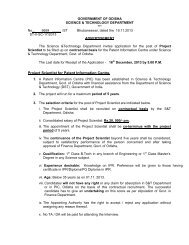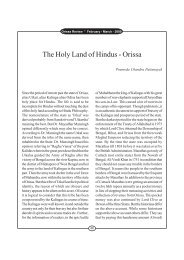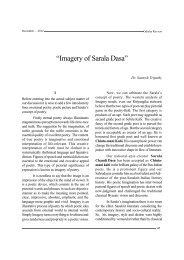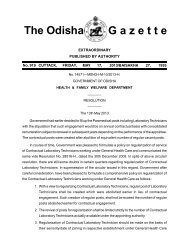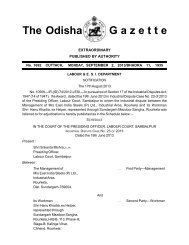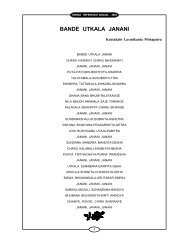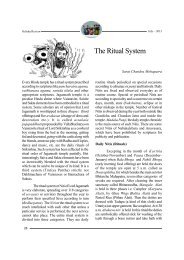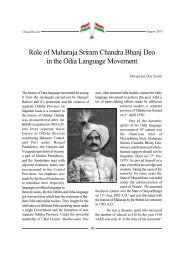Goddess Kichakeswari Temple at Khiching
Goddess Kichakeswari Temple at Khiching
Goddess Kichakeswari Temple at Khiching
Create successful ePaper yourself
Turn your PDF publications into a flip-book with our unique Google optimized e-Paper software.
September - October 2011<br />
Orissa Review<br />
<strong>Goddess</strong> <strong>Kichakeswari</strong> <strong>Temple</strong> <strong>at</strong> <strong>Khiching</strong><br />
Balabhadra Ghadai<br />
150 Kms away from Baripada, the headquarters<br />
of Mayurbhanj District and 25 Kms from<br />
Karanjia, the Sub-Divisional headquarters is<br />
situ<strong>at</strong>ed <strong>at</strong> modern <strong>Khiching</strong> (Khijinga Kotta), the<br />
ancient capital city of the Bhanja Kings from about<br />
the middle of the ninth<br />
century AD. to the middle<br />
of the twelfth century AD.<br />
It lies between 21.50<br />
degree north l<strong>at</strong>itude and<br />
85.50 degree east l<strong>at</strong>itude<br />
near the confluence of the<br />
rivers Khairibhandana and<br />
Kantakhairi. This<br />
wonderful land of<br />
fascin<strong>at</strong>ing beauty and a<br />
long tradition of art and<br />
architecture, exquisite<br />
temples and historical<br />
monuments speak volumes<br />
of its past glory.<br />
The religious<br />
history of the Bhanja Kings<br />
of <strong>Khiching</strong> is<br />
cosmopolitan, for<br />
Buddhism, Jain ism and other cults flourished side<br />
by side with Hinduism. The worship of the<br />
Panchadev<strong>at</strong>a, namely Vishnu, Siva, Surya,<br />
Ganap<strong>at</strong>i and Sakti were widely prevalent here.<br />
The Bhanja Kings were devout worshippers of<br />
Sakti as borne by the fact th<strong>at</strong> <strong>Kichakeswari</strong><br />
(Khijingeswari) or Chamunda was the tutelary<br />
deity of the Bhanja dynasty. Several images of<br />
Durga, Mahisasuramardini and Saptam<strong>at</strong>ruka<br />
bear evidence of the<br />
popularity of Saktism.<br />
The existing temple of<br />
<strong>Goddess</strong> <strong>Kichakeswari</strong> is<br />
not the original one. It was<br />
during the rule of Maharaja<br />
Purna Chandra Bhanja Deo<br />
th<strong>at</strong> a system<strong>at</strong>ic<br />
excav<strong>at</strong>ion of the Thakurani<br />
compound was first started<br />
by Raibahadur Rama<br />
Prasad Chand, who had<br />
been deputed for the<br />
purpose by Sir John<br />
Marsal <strong>at</strong> the request of the<br />
Maharaja. Mr. Chand<br />
during excav<strong>at</strong>ion of the<br />
Thakurani compound in<br />
1922-24 came across the<br />
found<strong>at</strong>ion of a gre<strong>at</strong> temple<br />
which measured 35’ square <strong>at</strong> the base.<br />
This found<strong>at</strong>ion represented an old<br />
temple’s vestiges which had long since<br />
27
Orissa Review September - October 2011<br />
disappeared in the limbo of history. The install<strong>at</strong>ion<br />
of <strong>Goddess</strong> <strong>Kichakeswari</strong> on the ruins on an<br />
earthen pl<strong>at</strong>form was an impromptu affair<br />
accomplished <strong>at</strong> a time when the circumstances<br />
were quite unfavorable. Chanda observed two<br />
things: (i) the old temple had enshrined a life-size<br />
image of Hara with many other life- size images<br />
as Parsadev<strong>at</strong>as / Parivaradev<strong>at</strong>as and<br />
Dwarapals (now preserved in the site Museum)<br />
and (ii) the temple had collapsed due to weak<br />
found<strong>at</strong>ion. It was quite unbearable for the Bhanja<br />
ruler, Maharaja Purna Chandra th<strong>at</strong> the family<br />
deity was being worshipped in a provisional<br />
structure. There was no dearth of m<strong>at</strong>erial.<br />
Standing on the ruins of the Thakurani’s compound<br />
it was quite n<strong>at</strong>ural for the king to search for and<br />
think of the possible ways and means to restore<br />
the monuments besides providing a temple for the<br />
family deity. The Report on the Administr<strong>at</strong>ion of<br />
Mayurbhanj 1923-24, p.81 para 5 clearly<br />
records.<br />
“Found<strong>at</strong>ions of the original temple in<br />
which the God Siva was enshrined have been<br />
traced. Over the shrine of the original temple<br />
stands small brick-built temple wherein the<br />
<strong>Goddess</strong> <strong>Kichakeswari</strong> is <strong>at</strong> present enshrined.<br />
At the request of the people of the locality, the<br />
Maharaja (Purna Chandra Bhanj Deo) with his<br />
brother, the Chhotrai Saheb (Pr<strong>at</strong>ap Chandra<br />
Bhanj Deo) visited the shrine on the 24th January<br />
1924 and promised to restore the original temple.”<br />
In his conserv<strong>at</strong>ion note J.A. Page,<br />
Assistant Superintendent of the Archaeological<br />
Survey of India, Central Circle, suggested th<strong>at</strong><br />
the brick-built shrine of the Thakurani be removed<br />
from the compound as its ugliness did not conform<br />
to the surroundings. The demolition of the shrine<br />
would make construction of a new shrine<br />
imper<strong>at</strong>ive, he wrote. At the request of the<br />
Maharaja the Director General of Archaeology<br />
asked Mr. Page to make a plan for a simple<br />
structure of Indo-Aryan style. Since it was<br />
decided to use the doorjamb, door lintel and three<br />
images on the three niches of the old temple in<br />
the proposed new temple, the Khandiya deula<br />
(ruined temple) was demolished. Therefore, the<br />
idea to arrange a plan / design was mooted. The<br />
weak found<strong>at</strong>ion of the old temple was considered<br />
unsuitable for erecting the proposed new<br />
structure. The Administr<strong>at</strong>ive report of 1933-34<br />
informs th<strong>at</strong> the Maharaja was in favour of<br />
building a temple of <strong>Khiching</strong> style.<br />
In 1924-25 the construction of a new<br />
temple for <strong>Goddess</strong> <strong>Kichakeswari</strong> was proposed<br />
and accordingly J.A. Page gave a plan of Indo-<br />
Aryan style of temple design. As the style of the<br />
<strong>Khiching</strong> temples were different from th<strong>at</strong> of<br />
temples of Bhubaneswar, it was decided by the<br />
Maharaja to have a design of a temple of <strong>Khiching</strong><br />
style. The first thing the Maharaja did was to build<br />
a site museum for the better preserv<strong>at</strong>ion of<br />
sculptures for which a large plot of land was<br />
acquired to extend the temple compound and to<br />
fence it with wire. The non-descript brick temple<br />
of the <strong>Goddess</strong> was demolished and removed<br />
from the compound. The <strong>Goddess</strong> was put in a<br />
newly constructed shed till a proper temple was<br />
built.<br />
Due to tragic de<strong>at</strong>h of Maharaja Purna<br />
Chandra Bhanj Deo in 1928 the progress in the<br />
m<strong>at</strong>ter was delayed for a few years and ultim<strong>at</strong>ely<br />
Babu Sailendra Prasad Bose, the Archaeological<br />
Supervisor of the department made the design<br />
on the d<strong>at</strong>a obtainable from the existing temple<br />
and his design finally received the approval of the<br />
Maharaja. This challenge of Mr. Bose was<br />
formidable one demanding hard work, dedic<strong>at</strong>ion,<br />
perfect skill, integrity and leadership. The work<br />
for the temple began before the close of the 1933-<br />
34 financial years and completed by the end of<br />
28
September - October 2011<br />
1941. The deity was installed on 14th March<br />
1942 amidst pomp and ceremony. The height of<br />
the temple measured 68’ above the ground level<br />
and a sum of Rs.80,000/- was spent in its<br />
reconstruction and conserv<strong>at</strong>ion.<br />
The temple in its restored form also<br />
adheres to the Orissan Rekha type of architecture<br />
with a peculiarity of its own i.e. absence of a<br />
porch. It is otherwise a Panchar<strong>at</strong>ha temple<br />
consisting of five pages (Pilasters). The sanctuary<br />
is square in the ground plan, rectangular parallelopiped<br />
from above the base, and surrounded by a<br />
curvilinear tower. The original temple was built in<br />
the tenth century A.D. and as such it is almost a<br />
contemporary of the Brahmesvar and Lingaraj<br />
temples <strong>at</strong> Bhubaneswar.<br />
The image of <strong>Kichakeswari</strong>, now being<br />
worshipped <strong>at</strong> the main temple <strong>at</strong> <strong>Khiching</strong> is the<br />
grim figure of the <strong>Goddess</strong> Chamunda. This figure,<br />
although broken in three parts has been joined<br />
together and inspires awe and fear among the<br />
devotees. According to N.N Vasu this image is<br />
one of the forms of Bhima, the emaci<strong>at</strong>ed body<br />
disclosing a hideous skeleton with the bones and<br />
ribs all laid bare.<br />
Orissa Review<br />
The <strong>Goddess</strong> is se<strong>at</strong>ed on a lotus issuing<br />
from the naval of Purusa. Over the head and back<br />
of the <strong>Goddess</strong> rises the figure of Airav<strong>at</strong>a. On<br />
other side of her crown there is a serpent with<br />
uplifted hood. Of the eight hands the left ones are<br />
in Abhaya and Varada poses and hold rosaries<br />
and a head where as two right hands hold a<br />
dambaru and a cup, the other two being<br />
completely damaged.<br />
Thus the temple of <strong>Goddess</strong><br />
<strong>Kichakeswari</strong> is a priceless embodiment of<br />
superb charm and inimitable grace, and occupies<br />
a significant place among the famous monuments<br />
of Orissa like Konark, Puri and Bhubaneswar as<br />
a sacred sanctuary of religious activities and the<br />
<strong>Goddess</strong> <strong>Kichakeswari</strong> in the form of eightarmed<br />
Chamunda of Sakta pantheon stands<br />
gloriously betokening the heyday of royal dignity<br />
and aristocracy.<br />
Balabhadra Ghadai, Principal, M.K. College, <strong>Khiching</strong>,<br />
Mayurbhanj.<br />
Genius does not argue, it cre<strong>at</strong>es. – Rabindran<strong>at</strong>h Tagore<br />
29



